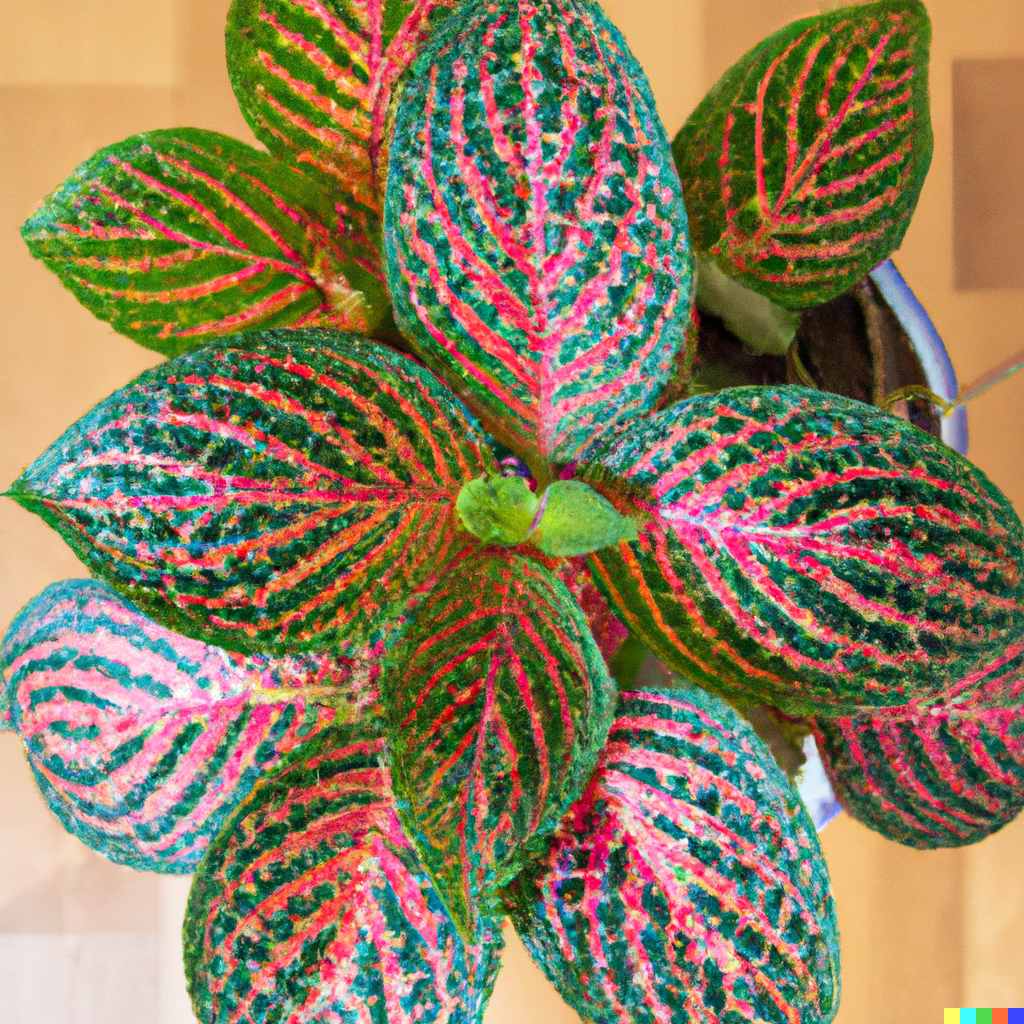The Fittonia albivenis, also known as the nerve plant, is a stunning tropical houseplant prized for its colorful leaves. The leaves are veined in red, white, pink, and green for a dramatic appearance. With its tropical origins, the Fittonia thrives in the warm, humid environment of a terrarium. This care guide provides tips for successfully growing Fittonia albivenis as a terrarium specimen. We cover ideal conditions, propagation, troubleshooting problems, and where to acquire this beautiful plant. Read on to learn how to showcase the nerve plant’s vibrant foliage in your home terrarium.
| Category | Details |
|---|---|
| Plant Family | Acanthaceae |
| Common Names | Mosaic plant Net plant Miniature mosaic plant Green spider flower White-vein Fittonia White-nerved Fittonia Red-nerved Fittonia Painted-leaf nerve plant White Anne Red Anne Pink Anne |
| Origin | Tropical rainforests of South America |
| Flowering | Rarely flowers indoors |
| Height and Growth | Grows 12-15 cm tall, spreading horizontally |
| Temperature | 18-27°C, avoid cold drafts |
| Humidity | Prefers 60-80% humidity |
| Growing Medium | Peat-based potting mix |
| Soil pH | Slightly acidic, 6.0-6.5 |
| Lighting | Bright indirect light, no direct sun |
| Watering | Mosaic plant Net plant Miniature mosaic plant Green spider flower White-vein Fittonia White-nerved Fittonia Red-nerved Fittonia Painted-leaf nerve plant White Anne Red anne Pink anne |
| Propagation | Stem cuttings in water or potting mix |
| Common Problems | Root rot, botrytis, mealybugs, fungus gnats |
| Toxicity | Non-toxic to humans and pets |
| Where to Buy | Online stores, nurseries, garden centers |
The Fittonia albivenis, also known as the nerve plant, is a stunning tropical houseplant prized for its colorful leaves. The leaves are veined in red, white, pink, and green for a dramatic appearance. With its tropical origins, the Fittonia thrives in the warm, humid environment of a terrarium. This care guide provides tips![]() for successfully growing Fittonia albivenis as a terrarium specimen. We cover ideal conditions, propagation, troubleshooting problems, and where to acquire this beautiful plant. Read on to learn how to showcase the nerve plant’s vibrant foliage in your home terrarium.
for successfully growing Fittonia albivenis as a terrarium specimen. We cover ideal conditions, propagation, troubleshooting problems, and where to acquire this beautiful plant. Read on to learn how to showcase the nerve plant’s vibrant foliage in your home terrarium.
An Overview of Fittonia Albivenis (Nerve Plant)
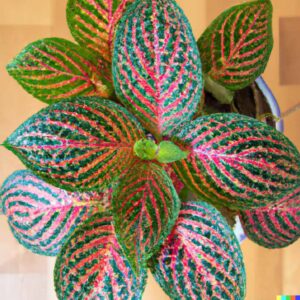
The Fittonia albivenis is a member of the Acanthaceae family of flowering plants. This family consists of over 4,000 diverse species, most of which are tropical or subtropical. Other popular houseplants in the Acanthaceae family include the colorful Aphelandra squarrosa or zebra plant, the Justicia brandegeeana or shrimp plant, and various Pachystachys species.
The genus Fittonia contains around 15-20 species that originate from tropical rainforests in South and Central America. Some other species besides F. albivenis include F. gigantea, F. verschaffeltii, and F. argyroneura. The most commonly grown indoor plant is F. albivenis.
Fittonias are herbaceous evergreen perennials. They have a spreading, low-growing habit, and fleshy stems. The leaves are opposite, short-petioled, and oval or elliptical in shape. Fittonias are distinguished by their stunning leaf venation patterns that make them stand out.
F. albivenis is characterized by dark green leaves with contrasting white, red, or pink veins that resemble neural pathways – hence the common name nerve plant. The striking leaf patterns are why Fittonias are so prized as ornamental indoor plants. They add unique visual interest and texture.
The foliage of F. albivenis can vary between different cultivars. Some have mainly white veining while others exhibit pink or red accent veins. There are also versions with different colored edges like Fittonia ‘Skeleton’ and Fittonia ‘Red Anne’. The versatility of available varieties lets you choose the leaf coloring that best complements your terrarium design![]() .
.
Common Names
The nerve plant is the most widely used common name for Fittonia albivenis, which refers to the resemblence of its veined leaves to nerve pathways. Some other common names for this species include:
- Mosaic plant
- Net plant
- Miniature mosaic plant
- Green spider flower
- White-vein Fittonia
- White-nerved Fittonia
- Red-nerved Fittonia
- Painted-leaf nerve plant
- White Anne
- Red Anne
- Pink Anne
The “mosaic plant” name comes from the mosaic-like patterns formed by the contrasting leaf venation. “Net plant” and “miniature mosaic plant” also refer to the web-like veining.
The “green spider flower” describes the plant’s low mounding shape and spreading foliage that resembles a green spider. The white-vein, white-nerved, and red-nerved Fittonia names all call attention to the distinctive coloring of the leaf veins.
The “Anne” monikers like white Anne, red Anne, and pink Anne refer to popular cultivated varieties of F. albivenis selected for certain vein colors.
Finally, the “painted-leaf nerve plant” combines both the neural-looking veins and the painted appearance of the colorful leaves.
These various common monikers highlight the Fittonia albivenis’ defining features – its low spreading habit and especially the intricate, eye-catching venation on its leaves that resembles neural pathways or mosaics. The nerve plant name has stuck as the most commonly recognized, emphasizing the plant’s unique beauty.
Origin
The Fittonia albivenis plant originated in the tropical rainforests of South America and Central America. They are native to countries like Peru, Colombia, Panama, and Ecuador located near the equator. Fittonias naturally grow in the warm, humid, shady forest understory. Their native range extends across northern South America in the regions west of the Andes Mountains. You’ll find them in rainforests at elevations below 1000 meters where conditions stay warm and wet year-round. Fittonia albivenis has adapted to thrive in dappled sunlight and soak up constant moisture from tropical rainfalls.
Flowering
The Fittonia albivenis rarely flowers when grown as a houseplant. It takes very bright lighting, higher temperatures, and high humidity to initiate flowering indoors, so it is an uncommon occurrence. In their natural habitat, Fittonias may flower in response to seasonal cues. But when grown as houseplants, they tend to focus energy on foliage growth rather than blooms. Some flowering may occur during summer months if a Fittonia plant is moved outdoors where it receives more direct sunlight and warmth. But typically, the colorful leaves are the main attraction of this plant, not its small white or pink flowers.
Height and Growth
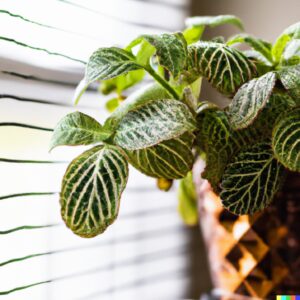
Fittonia albivenis grows to a height of around 12-15 cm tall but spreads horizontally across the ground in its native habitat. The plant has a low, spreading mound shape with each stem reaching up to 18 cm long. In rainforests, the Fittonia grows along the forest floor and sends out trailing stems between the tree roots and lower plants. The spreading habit allows the plant to maximize light exposure from small breaks in the canopy above. Indoors, Fittonia albivenis maintains its spreading growth form. It can be grown in hanging baskets or allowed to trail from elevated containers. The plant combines nicely with taller houseplants.
Temperature
Fittonia albivenis thrives in warm temperatures between 18-27°C. Avoid exposing it to colder drafty areas. As a tropical plant, it flourishes with consistent warmth. Coming from steamy rainforest environments near the equator, Fittonia albivenis does not tolerate any frost or freezing cold. Keep it away from cold windows, vents, or drafty doors during winter months. Moving between drastically different temperatures can shock the plant and cause leaf spotting or drop. Maintain indoor temperatures in the ideal range year-round. You can move it outdoors in summer if temperatures remain warm.
Humidity
High humidity levels of 60-80% should be maintained for Fittonia albivenis. The tropical origins mean humidity is essential for healthy growth and vivid leaf coloring. In its native South American rainforests, Fittonia albivenis naturally experiences high humidity levels from frequent rainfall, moisture-laden air, and shady understory conditions. Recreate this humid environment indoors by misting the plant daily, using a pebble tray, or placing its container on a humidity tray filled with pebbles and water. Low humidity causes the margins or the leaves to dry and brown. Ensure the surrounding air stays consistently humid.
Growing Medium
A peat-moss-based potting mix is ideal for Fittonia albivenis. The soil should retain moisture but also provide good drainage and aeration for the roots. Look for a mix containing peat along with added perlite or vermiculite to prevent heavy compaction and waterlogging. Or you can amend regular potting soil with extra perlite, coco coir, or orchid bark to improve drainage and air circulation. Avoid soils that get extremely dense or soggy when wet. The roots require a steady balance of moisture and oxygen.
Soil pH
The preferred soil pH for growing Fittonia albivenis is slightly acidic, between 6.0-6.5. Avoid alkaline soil conditions. Tropical plants like Fittonia tend to prefer neutral to mildly acidic soil rather than a very high or low pH. When potting or repotting your Fittonia, test the soil pH with a kit and amend with peat moss or compost to lower the pH if needed. Alkaline soils can cause leaf discoloration and impaired nutrient absorption for the plant. Check pH annually and adjust as required.
Lighting Requirements
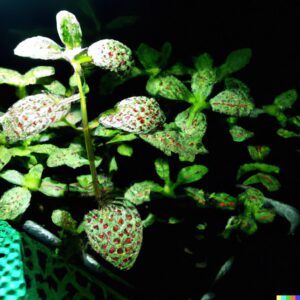
Fittonia albivenis needs bright, indirect light to thrive. Some early morning or late day direct sun is tolerated but afternoon sun will scorch the leaves. In its rainforest habitat, the plant grows beneath the canopy receiving ample ambient light but no harsh direct sun. Provide similar conditions indoors by placing it near an east or west window where light is bright but gentle and filtered. Moving the plant further away from light sources can cause leaves to fade and lose their vivid color over time.
Watering Requirements
Water Fittonia albivenis thoroughly whenever the top inch of the soil becomes dry. Take care not to overwater or leave it soggy, which can lead to root rot. Tropical understory plants like Fittonias are accustomed to high rainfall in forests. But good drainage is still important to prevent waterlogged conditions at the roots. Allow the soil to partially dry out between waterings, then soak until it runs freely from the drainage holes. Always empty excess water from the saucer beneath. This balance provides needed hydration while avoiding potential problems.
Propagation
Propagate new Fittonia albivenis plants from stem cuttings rooted in water or a potting mix. Keep the humidity high while they develop roots. Take 3-6 inch stem tip cuttings in spring using clean, sharp scissors. Remove the lowest set of leaves and place the cut end in water or a rooting hormone followed by a moist potting mix. Cover with a plastic bag to maintain humidity levels around 80-90%. Check for root development after 4-6 weeks. Once rooted, transplant into pots using well-draining soil. Keep newly propagated plants sheltered while adjusting to lower indoor humidity.
Common Problems
Some common issues with Fittonia albivenis include root rot from overwatering, botrytis blight, mealybugs, and fungus gnats. Maintain proper care to prevent problems. Root rot stems from overly moist soil and can be prevented by allowing the soil to partially dry between waterings and providing good drainage. Botrytis blight is a fungal infection worsened by high humidity, while mealybugs and fungus gnats both relate to poor sanitation. Keep humidity at ideal levels, isolate any infected plants, and clean pots/tools to avoid spread.
Toxicity
Fittonia albivenis is non-toxic to both humans and pets, making it safe for homes with children or animals. The plant does not produce any toxic compounds or substances that could cause illness if ingested. The main hazards are the common allergic reactions that may occur when handling or being exposed to any plant. Wear gloves if you have very sensitive skin. Otherwise, Fittonia can be grown safely around people and pets without concern over toxicity.
Where to Buy
You can buy Fittonia albivenis plants online, at plant nurseries, or from garden centers and hardware stores. Look for healthy green leaves without brown spots or damage. Select plants with vivid leaf veining and no signs of pests. Purchase from reputable sellers. Ensure the plant has not been overwatered or kept in dim lighting which causes weaker growth. With its popularity as a houseplant, nerve plant availability continues improving across various retailers.
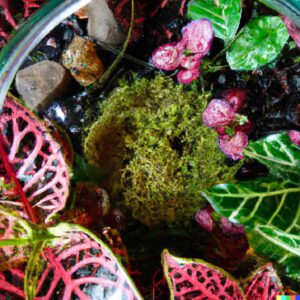
Conclusion:
The Fittonia albivenis or nerve plant is an excellent choice for adding striking beauty to terrariums and other indoor plant displays. Its colorful leaves with painted veining provide unique texture and interest. Follow the care guidelines in this article for lighting, humidity, watering, and propagation to keep your nerve plant thriving. Showcase Fittonia albivenis as a focal point in your home terrarium![]() or mixed planting.
or mixed planting.

